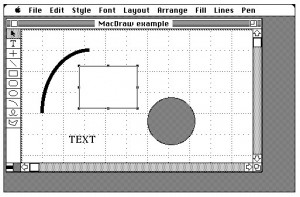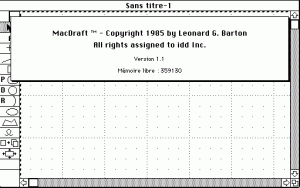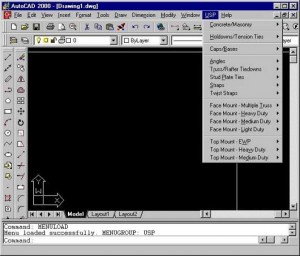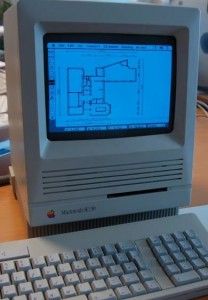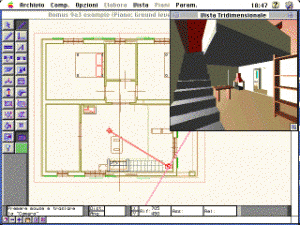The evolution of CAD on Macintosh
Introduction
When the first Macintosh 128 K came out in 1984, it had 3 programs, each of which – in their own way – were the basis for generations of other programs, many of which are commonly used today.
These programs were MacWrite, MacPaint and MacDraw (for vectorial drawing).
All three used the new graphic user interface and a new pointing device called a “mouse”. Also, they were WYSIWYG (What You See Is What You Get) – what you see on the monitor is what comes out when printed.
Nowadays this seems normal, but then, it wasn’t. In fact, even today many CAD users, particularly AutoCad™, do not adopt this philosophy, and the video and print versions of the drawing are completely different.
MacWrite was the prototype of all word processing software that followed, including Microsoft Word, whose first version was created on Macintosh.
MacPaint was the prototype of all painting software that followed, starting from Adobe Photoshop, whose first version was created on Macintosh.
MacDraw was the prototype of all vectorial graphic software such as FreeHand and Illustrator, these too created on Macintosh, as well as for a series of CAD programs that borrowed from MacDraw the concepts of a simple, instinctive user interface and visual control of the final result. Of these early CADs, we might mention MacDraft, PowerDraw and MiniCAD. Soon after came the architectural programs Radarch, Architrion and Domus.Cad.
Here, however, right from the start there was a big difference between the Mac CAD programs, deriving from the MacDraw philosophy with its mouse pointing device, and the CAD programs, first on DOS and later on Windows, deriving from the command line philosophy, where the pointing device was a tablet, as in the concept of CAD on WorkStation, used also by AutoCad™ of AutoDesk. This became particularly evident in 1992 when AutoDesk released AutoCad 12 for Macintosh. The software was completely “snubbed” by Mac users and very few of them bought it, preferring to continue using programs created on Mac, with MacDraw philosophy and user interface.
Two different philosophies
The principle underlying CAD software for Mac was, as said, to have on screen an exact representation of the final printout – so a white background like paper, thicknesses as they would be printed and use of printed colors. The pointing device was the mouse.
In the beginning Windows did not exist and PCs were heavily DOS-reliant. CAD software on DOS grew out of CAD WorkStation philosophy, where the pointing device was the tablet and the command line was text. Even when Windows came along nothing changed. CAD for Windows had a black background, the lines all had the same thickness, the colors were used to represent different thicknesses and the end result was not clear until the drawing had been printed and plotted.
In CAD for Mac, commands were mainly carried out by mouse using Select-Command. That is, you selected some elements and then you could use a series of functions on the selected items – move, rotate, change color, change thickness, etc. – as we now do using today’s word processing software.
In CAD for Windows, commands were mostly given by command lines. And even when the tablet or mouse were used, it was always Command-Selection. For example, to move something, you clicked on the Move icon and then indicated the elements to be moved. To cancel, you clicked on the Cancel icon, after which you indicated elements to be canceled. And so on.
Another example was the integration with the operating system. Generally, CAD programs for Mac were highly integrated with the functions of the operating system. It was normal to copy/paste from one program to another, even if they were very different. For example, you could select a part of a CAD drawing and paste it into a report in the word processing program. Nowadays this seems all very normal, but in the Eighties it seemed like a miracle. The programs, at first simple, incomplete even, grew bit by bit, along with the potential of the operating system, in an organic and innovative way, without being chained to the past.
Programs for DOS and Windows, not only AutoCad™, but also MicroStation™, VersaCad and others, were a subset of more powerful and complete programs created on WorkStations like SUN and mini-computers like Digital, with various types of compromise. These programs also grew and improved over time, overtaking their original programs for power and functions, but without abandoning the original philosophy.
3D architectural CADs
From the very start Macintosh was popular in creative sectors, whether among advertising designers, with programs like FreeHand, Photoshop, PageMaker, Illustrator and others, or architects, using their programs for 3D parametric architectural design.
Macintosh’s first architecture program was Radarch, by Graphisoft, which later became ArchiCad, created on Lisa and present on Macintosh from the start. Then came Architrion.
Macintosh was appreciated and used early on in the field of architecture, with an above-average market presence compared with other categories, except for desktop publishing, where it has always been number one.
Some pioneer companies in Italy – in addition to Interstudio, we might mention Abacus, Cigraph, Italosoft and Softing – produced a series of professional drawing programs for every requirement.
Already in 1990 Domus.Cad was released, one of the very first parametric architectural CADs for Mac in the world and the very first architectural CAD in Italy.
From the start, Domus.Cad was known for its immediate, simple and intuitive approach typical of Mac software, as well as for the particular attention paid to Italian design issues such as, for example, restoration work. Later, like many other Mac-born programs, Domus.Cad was also transferred to the Windows platform, bringing to it these advantages of advanced user-friendliness and rapid, intuitive use.
Why use Domus.Cad as a CAD for Mac?
With Apple’s extraordinary success in recent years and Macintosh computers’ growing market share, especially in the professional field, the Mac Os X operating system has become of economic interest to all producers of CAD software. Resulting in migration to Macintosh of AutoCad™ and of various AutoCad-like programs that have cloned AutoCad™’s user interface and use of drawing format.
But these programs, conceived and developed from a philosophy that – as we have seen – is the opposite of Macintosh’s philosophy, do not exploit the machine and the operating system to best advantage. Simply put, they were not made for Mac.
At first, to a new Macintosh user, fresh from the world of Windows, using programs that work on Mac exactly as they did on Windows has great appeal. But long term, this advantage turns out to be a disadvantage, due to time spent learning the new functions, integration with other programs on the computer, similarity of operating modes of various programs, integration with the operating system and its more specific functions.
The move to Mac Os X and to Macintosh, on the other hand, could be an excellent opportunity for facing the latest challenges – including economic ones – of the design world, with simple, immediate, integrated and effective solutions, that are also fun to use and inspiring.
Domus.Cad has the perfect answer to this challenge, with a 3D parametric architectural program, BIM, created and developed on Mac, using Mac technology such as QuickTime, Quartz and OpenGl..
Domus.Cad is a genuine and complete BIM (Building Information Modeling) program. Not only does it contain intelligent parametric elements, but it also slots into an integrated drawing system that ranges from topographic and architectural surveying right through to a complete 3D design.
AutoCad is a trademark of AutoDesk. Microstation is a trademark of Bentley. ArchiCad is a trademark of Graphisoft. Domus.Cad is a trademark of Interstudio. MacDraw is a trademark of Apple Computer. MacDraft is a trademark of MicroSpot Ltd.



